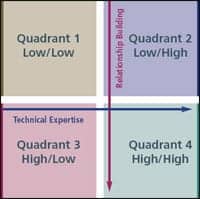
|
||
| Brian Taylor, AuD, is the global training manager for Amplifon, Plymouth, Minn. He is currently working at the Amplifon corporate headquarters in Milan, Italy. | ||
For the first half-century of our history as hearing care providers, professional success was basically defined by your academic degree and real-world experience. Simply go to school, obtain an advanced degree, hang a shingle outside your door, and you were on the path to success. The patient-professional bond, which is critical to long-term professional success, was implicitly created by virtue of your training and expertise.
A Startling New Reality
As hearing care professionals, we must now adapt to a startling new reality. Today, thanks in part to the Internet and search engines like Google, patients have access to an abundance of information. These vast quantities of information lead to informed and savvy patients who know they have an unprecedented amount of choice.
From a business perspective, this new reality has one important implication: Patients, rather than organizations, largely call the shots when it comes to the overall productivity of your business. In today’s hypercompetitive business climate, if a customer has one bad experience in your office, they are not only likely to defect, but spread plenty of negative word-of-mouth opinions about their treatment. Today, even the most timid patients know they can take their business elsewhere—if not to another clinic, then to the Internet.
Responding to the New Reality

|
| FIGURE 1. Professional development matrix based on technical expertise (horizontal axis) and relationship building (vertical axis). |
Customer satisfaction is maximized when employees feel engaged in their work.1,4 This concept is referred to as the Service-Profit Chain1 or the Empathy Engine,2 and uses data collected from several industries to show the direct positive relationship between profits, employee satisfaction, and customer satisfaction. From a professional development standpoint, this means that managers need to provide coaching, support, and guidance to their staff in order to get the most out of their skills. It is the day-to-day application of these skills that can set your business apart from your competition.
Knowing exactly what skills have the biggest impact on revenue and patient satisfaction can be a daunting task. Successful managers, however, are able to narrow the professional development maze down to two critical variables: Relationship building and technical expertise.
1) Relationship building. Your effectiveness as a professional is largely determined by your ability to form strong relationships with patients. Any investment you can make toward building the relationship with the patient is likely to pay off in a business transaction as well as other referrals.
A friendly greeting, good listening skills, and an ability to ask open-ended questions are tactics geared to build the relationship.
Successful professionals know that they must constantly be striving to improve their skills by frequently putting themselves in the customer’s shoes, anticipating when the customer is distressed, frustrated, needing help, etc, and acting upon it.
2) Technical expertise. Technical expertise relates to the professional’s ability to accurately assess hearing disorders and select and fit hearing aids using the most current methods. A substantial amount of technical expertise relies on the application of evidence-based practice. The more you know (and can communicate effectively) about how hearing aid features relate to individual benefits, the more likely you are to be perceived as a true expert. Moreover, the better you understand how to apply evidence-based practice, the more likely you are to be perceived by the patient as a true expert.
The matrix shown in Figure 1 is geared to helping you focus your thoughts on identifying areas of improvement when it comes to professional development. Notice that there are two axes: the vertical axis represents relationship building, and the horizontal scale represents technical expertise. Both are on a 0 to 10 scale, where 0 is the lowest score, and 10 is the highest score you can rate yourself.
Hearing care professionals can use this four-quadrant matrix to self-assess their skills in these two areas. Managers can also use this matrix to identify areas of improvement and establish a clear professional development plan when coaching their staff.
Employing Evidence-based Practice Guidelines as a Process

|
| TABLE 1. One common method for assessing levels of evidence when using EBP. From Bentler 2007.5 |
In theory, all professionals are able to use this matrix to identify areas of improvement and, with proper coaching and support, develop them. The reality is that, for various reasons, the typical professional can find this difficult to do independently. The question becomes how can an organization institutionalize professional standards—making professional standards a sustainable advantage throughout the organization?
One strategy is to utilize a program that incorporates evidence-based practice guidelines. A review of key business indicators would confirm the need for this idea. Historically, return for credit rates as measured by manufacturers have hovered around 20% to 25%. The number of hearing aids ending up in the dresser drawer continues to be at 15% to 18%. The number of patients who shop around or decide not to buy hearing aids when it is time to repurchase is more than 50%. Although recent reports of overall satisfaction have increased, the number of dissatisfied patients has not changed dramatically over the past several years.
The emergence of evidence-based principles (EBP) into the clinical decision-making process can be viewed as an industry-changing event.5 In short, evidence-based principles is a process by which hearing care professionals make treatment decisions based on the best available evidence. Evidence is classified along a six-level hierarchy in which meta-analysis of randomized controlled clinical trials represents the highest or best level of evidence (Table 1). EBP requires clinicians to rigorously review and analyze research, and act (or not act) upon the findings when making important clinical decisions.
Over the last 3 years, EBP has gained favor as the preferred method for making clinical decisions in our field, and two issues of the Journal of the American Academy of Audiology, as well as several articles, have been dedicated to the topic. There remains, however, a considerable gap between what the evidence suggests we do, and what actually happens when it comes to dispensing hearing aids. Evidence-based practice guidelines that are followed, or better yet a certification program that institutionalizes these standards, are one way to help ensure EBP is employed in your hearing care setting.

|
| TABLE 2. Changes in top-line growth associated with a 6% increase in average selling price (ASP). |
Cases study. Two years ago, Sonus began a professional certification program in which approximately 300 providers were eligible to become certified.5 By the end of the first year, 10% of them had successfully met all the criteria to become certified. By the end of the second year, approximately 40% of the eligible providers were certified.
To determine the relationship between certification and business performance, one key business variable was examined: average selling price (ASP). Our analysis found that clinics with a certified provider had a 6% higher ASP than those without a certified provider. Although a 6% increase may not be statistically significant, from a business standpoint it is.
For example, let’s say that a typical clinic dispenses 250 hearing aids annually. Table 2 shows the difference in both ASP and gross revenue for one office that experiences a 6% increase in ASP and when the number of units dispensed on an annual basis is held constant.
Notice in this example that the 6% improvement in ASP results in $27,000 in top-line growth for just one provider in a single office. Obviously, other key business variables, like cost of goods, must be accounted for if this improvement is to result in any bottom-line profit. Based on these findings, however, certified providers are more efficient than their noncertified colleagues. That is, they generate more revenue expending the same amount of time and effort.
The more important question, perhaps, is does this 6% increase in ASP result in a concomitant improvement in patient satisfaction? Unfortunately, due to the many variables associated with measuring patient satisfaction, it is extremely difficult to show a direct relationship between following an evidence-based protocol and improved patient satisfaction.

|
| FIGURE 2. A comment card like this one gives patients the ability to provide feedback and dispensing professionals the ability to assess their performance relative to patient satisfaction and benefit. |
We have found, however, some indirect relationships between patient satisfaction and a certification program. For example, there is evidence to suggest that certified providers who hand out more patient comment cards (Figure 2) are more productive.6-8 While handing out more cards certainly doesn’t equate to higher levels of patient satisfaction, there is evidence suggesting that those patients who are asked about their level of satisfaction routinely report higher satisfaction scores on measures of service quality.9 Additionally, there is indirect evidence showing that the consistent use of a clinical test protocol results in higher patient satisfaction.9-11
Based on the evidence, a certification program incorporating evidence-based practice guidelines can result in improved productivity. Although a direct relationship between a certification program and higher patient satisfaction is difficult to measure given the many dependent variables, there is a clear trend supporting the idea that certified providers are more likely to take the time to survey their patients about their levels of satisfaction, and conduct clinical procedures using evidence-based practice guidelines. All are actions likely to result in higher levels of patient satisfaction.
Given the possibility that more hearing care professionals than ever are cutting corners, resulting in one-sixth of hearing aids in the drawer, a clinical certification program appears to be an effective method for raising the bar on high-quality patient care.
References
- Heskett J, Jones G, Loveman W, Sasser L, Schlesinger L. Putting the service-profit chain to work. Harvard Business Review. March-April 1994:164-170.
- Entel T, Grayson S, Huttner N. The Empathy Engine: Turning Customer Service into a Sustainable Advantage. Katzenback Partners White Paper. www.katzenbach.com/Work/Publications. Accessed January 24, 2008.
- Beaujean M, Davidson S, Madge S. The moment of truth in customer service. McKinsey Quarterly. 2006;1:62-73.
- Fornell C, Mithas S, Morgeson F, Krishnan M. Customer satisfaction and stock prices: high returns, low risk. Journal of Marketing. 2006;70:3-14.
- Bentler R, Eiler C, Hornsby B, Moodie ST, Olson L, Valente M. Practical approaches to evidence-based practice. Hearing Review. 2007;14(6):36-41.
- Taylor B. Putting evidence into practice using a certification program. Hear Jour. 2006;60(10):58-61.
- Taylor B, Fusco M. The results of a clinical certification program. Poster presented at: AAA annual meeting; April 2007; Denver.
- Taylor B. Why quality matters. Hearing Review. 2005;12(9):36-38,76.
- Kochkin S. On the issue of value: hearing aid benefit, price, satisfaction, and brand repurchase rates. Hearing Review. 2003;10(2):12-25.
- Clutterbuck S. Hearing aid performance in the “real world”—customer dissatisfaction with loudness comfort. Paper presented at: EUHA annual convention; October 2007; Nurnburg, Germany.
- Manager Tools LLC. Manager Tools Basics podcast. www.manager-tools.com. Accessed January 24, 2008.
Correspondence can be addressed to HR at [email protected] or Brian Taylor at .





